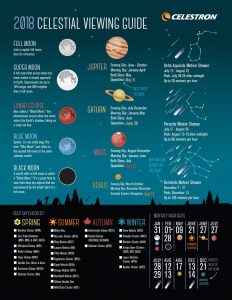While 2018 is almost halfway over, there are still plenty of cool celestial events to watch during the rest of the year.

While 2018 is almost halfway over, there are still plenty of cool celestial events to watch during the rest of the year.
One of the biggest is Mars at Opposition on July 21. From now until then, Mars will move closer and closer to Earth. In fact, on July 31 Mars will be the closest to Earth it has been in over 60,000 years and will be the brightest it has been in the sky since 2003.
Our friends at Celestron have put together a list of this year’s celestial events. Included are:
– June 21: Summer Solstice – Summer is here with the longest day of the year. Stay outside longer and observe the Sun with proper solar safe equipment. In the Southern Hemisphere, today is the Winter Solstice and is the shortest day of the year which is great for starting celestial observing earlier in the evening.
– June 27: Saturn at Opposition – See Saturn and its rings while the planet is closest to Earth. While Saturn is at opposition, the planet will be brighter than any other time of the year and will be visible from Sun down to Sun up. While you are observing Saturn, make sure to check out its orbiting moons.
– July 13: Partial Solar Eclipse – A partial solar eclipse will be visible in southern Australia including Tasmania, the Pacific Ocean, and the Indian Ocean. A partial solar eclipse occurs when the Moon covers part of the Sun and can only be viewed with proper solar safe equipment.
– July 27: Total Lunar Eclipse – The second eclipse for July and the second lunar eclipse of 2018! The total lunar eclipse will be visible throughout Europe, Asia, Australia, Africa, the Atlantic Ocean, the Indian Ocean, and Antarctica. A total lunar eclipse occurs when the Moon passes through the Earth’s shadow and creates a Blood Moon.
– July 27: Mars at Opposition – See Mars, the red planet, while it is closest to Earth. While Mars is at opposition, the planet will be brighter than at any other time of the year and will be visible from Sun down to Sun up.
– July 28, 29: Delta Aquarids Meteor Shower – Pull an all-nighter on the 28th and enjoy the Delta Aquarids meteor shower. Although the meteor shower runs annually from July 12th to August 23rd, the best time to view is July 28th and 29th after midnight. This shower produces up to 20 meteors per hour at its peak and is the remnants of comets Marsden and Kracht.
– August 11: Partial Solar Eclipse – The third and last partial eclipse for 2018! A partial solar eclipse will be visible in north-eastern Europe, north-western Asia, northern parts of Canada, Greenland, the Atlantic Ocean, and the Arctic. A partial solar eclipse occurs when the Moon covers part of the Sun and can only be viewed with proper solar safe equipment.
– August 12, 13: Perseids Meteor Shower – Pull an all-nighter on the 12th and enjoy the Perseids Meteor Shower–said to be one of the best meteor showers to observe. Although the meteor shower runs annually from July 17th to August 24th, the best time to view is August 12th and 13th after midnight. This shower produces up to 60 meteors per hour at its peak and is the remnants of comet Swift-Tuttle.
– August 17: Venus at Greatest Eastern Elongation – The best time to view the planet Venus is at its greatest eastern elongation. Venus will be at 45.9° from the Sun and will look the brightest in the west after sunset.
– December 13, 14: Geminids Meteor Shower – The meteor shower you’ve been waiting for all year is considered by many to be the best shower in the heavens. The Geminids Meteor Shower produces up to 120 meteors per hour at its peak and is the remnants of comet 3200 Phaethon. Although this shower runs annually from December 7th to December 17th, the best time to view is December 13th after midnight.
– December 21: December Solstice – Winter is here with the shortest day of the year. Start observing celestial objects earlier as the nights are longer. In the Southern Hemisphere, today is Summer Solstice and is the longest day of the year which is great to stay outside longer to observe nature and solar observe with proper solar safe equipment.



